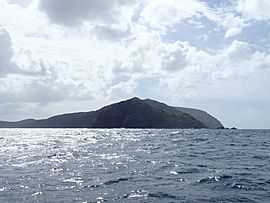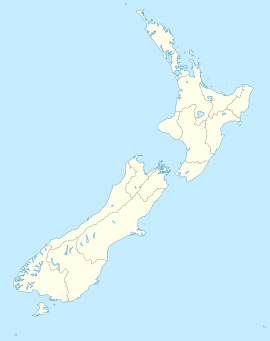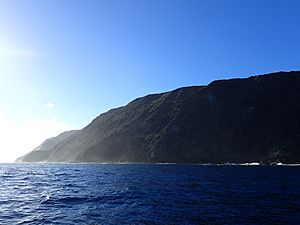North Cape (New Zealand) facts for kids
Quick facts for kids North Cape / Otou |
|
|---|---|
| Otou (Māori) | |

Murimotu Island (foreground) with the Lighthouse just visible on top, Otou just behind the light to the right and Surville Cliffs extending out to the right in the background
|
|
| Coordinates | 34°24′56″S 173°03′04″E / 34.415463°S 173.051111°E |
| Geology | Cape |
North Cape, also known as Otou in Māori, is the very top point of New Zealand's main islands. It sits on the northeastern tip of the Aupōuri Peninsula. This special place is about 30 kilometers east and 3 kilometers north of Cape Reinga.
The name "North Cape" can mean a few different things. Sometimes it refers only to the cape known as Otou, which looks out over Murimotu Island. Other times, it means just the eastern point of Murimotu Island itself. It can also refer to the entire large headland. This area stretches about five kilometers from Murimotu Island westwards to Kerr Point, and includes the famous Surville Cliffs.
Contents
History and Naming
North Cape is one of New Zealand's four main "Cardinal Capes." These capes mark the north, east, west, and south points of the country. North Cape was named by James Cook, a famous explorer. He named it during his first voyage to New Zealand between 1769 and 1770. At that time, the other Cardinal Capes were called Cape East, West Cape, and Cape South.
How North Cape Was Formed
Long ago, North Cape was actually an island. It was created by a volcano that erupted underwater. Over time, ocean currents carried sand and dropped it in the sea. This sand built up and formed a natural sand bridge called a tombolo. This tombolo, known as Waikuku Flat, eventually connected the island to the rest of the Aupōuri Peninsula. Today, the headland and the flat area together form the North Cape Peninsula.
Protecting Nature: Scientific Reserves
A big part of North Cape is protected within the North Cape Scientific Reserve. This reserve was created to keep the area's unique plants and animals safe. Some of these plants are found nowhere else in the world, growing only on the Surville Cliffs.
To help protect these special species, an electric fence was put up in 2000. This fence acts like a "mainland island." It keeps out animals like possums, wild pigs, and semi-wild horses that could harm the native plants. The reserve is closed to the public and is managed by the Department of Conservation (DoC).
Much of the Waikuku Flat area is also protected in another DoC reserve, called the Mokaikai Scenic Reserve. This reserve stretches south towards Parengarenga Harbour. Unlike the North Cape Scientific Reserve, the Mokaikai reserve is open to the public. However, to get there by land, you need to cross land owned by Māori tribes. You must get a permit from the Māori group in charge before crossing their land. There's also another strip of Māori land between the Mokaikai reserve and the North Cape reserve. This land includes the southern part of North Cape and the northern edge of Waikuku Flat. It goes from Kerr Point on the north coast to Tokatoka Point on the west coast.
Surville Cliffs: A Special Place
Hikurua / de Surville Cliffs are the northernmost point of mainland New Zealand. They are located right at the tip of North Cape. Sometimes, these cliffs were mistakenly called Kerr Point, but the real Kerr Point is a bit further west.
The first European to discover these cliffs was Jean-François-Marie de Surville. He sailed his ship, the St Jean Baptiste, to New Zealand in December 1769. He was looking for a safe place to care for his sick crew. He found the cliffs just a few days before James Cook saw them.
The cliffs are made of special rocks called serpentinised peridotite mafic rocks. These rocks create a unique environment that supports many rare and endangered plants. These plants are found only in this small area. Some of these unique plants include:
- Pittosporum ellipticum subsp. serpentinum
- Hebe brevifolia
- Hebe ligustrifolia
- Helichrysum aggregatum
- Leucopogon xerampelinus
- Pimelea tomentosa (sand daphne)
- Phyllocladus trichomanoides (tanekaha)
- Pseudopanax lessonii (coastal fivefinger)
- Uncinia perplexa (Surville Cliffs bastard grass)
See also
 In Spanish: Cabo Norte (Nueva Zelanda) para niños
In Spanish: Cabo Norte (Nueva Zelanda) para niños



